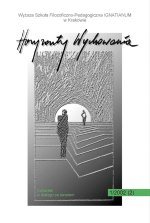Telewizja – druga szkoła
Abstract
Powszechnie wiadomo, że dzieci w wieku szkolnym w większości
krajów europejskich codziennie oglądają telewizję przez
około 2.5 do 3 godzin. Jeśli do tego dodamy czas spędzony na
słuchaniu radia, czytaniu gazet i kolorowych magazynów, „błądzeniu”
po Internecie i korzystaniu z innych mediów „wolnego
czasu”, to całkowity czas poświęcony mediom przez dzieci w wieku
9-15 lat należałoby oszacować na 4-6 godzin dziennie.
Dla niektórych nauczycieli i rodziców, którzy zauważają, że
uczniowie spędzają mniej czasu na czytaniu i odrabianiu lekcji,
może to być wręcz sytuacja alarmowa. Obawiają się oni, że
dzieci nie zostaną objęte zajęciami rozwijającymi sprawności
społeczne, zaangażowanie w rodzinę i Kościół oraz pobudzające
twórczo hobby.
Copyright (c) 2017 HORIZONS OF EDUCATION

This work is licensed under a Creative Commons Attribution-NonCommercial-NoDerivatives 4.0 International License.
Authors who publish with this journal agree to the following terms:
- Authors retain copyright and grant the journal right of first publication with the work simultaneously licensed under a CC BY-NC-ND licence that allows others to share the work with an acknowledgement of the work's authorship and initial publication in this journal.
- Authors are asked to enter into separate, additional contractual arrangements for the non-exclusive distribution of the journal's published version of the work (e.g., post it to an institutional repository or publish it in a book), with an acknowledgement of its initial publication in this journal.
Authors are permitted and encouraged to post their work online (e.g., in institutional repositories or on their website) prior to and during the submission process, as it can lead to productive exchanges, as well as earlier and greater citation of published work (See The Effect of Open Access). We advise to use any of the following reserach society portals:





